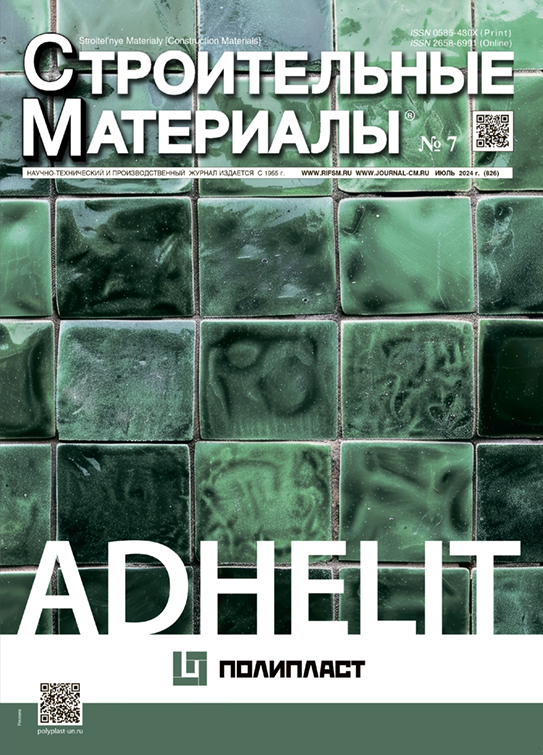Оптимизация составов штукатурных смесей на гипсовом вяжущем с применением REOLIN RA 120
- Авторы: Арасланкин С.В.1, Бурьянов А.Ф.2, Щанкин М.В.1
-
Учреждения:
- НПО ООО «Экспонента»
- Национальный исследовательский Московский государственный строительный университет
- Выпуск: № 7 (2024)
- Страницы: 18-25
- Раздел: К проведению XXIV Международной конференции производителей сухих строительных смесей BALTIMIX-2024 (20–23 августа, г. Пермь)
- URL: https://journals.eco-vector.com/0585-430X/article/view/635035
- DOI: https://doi.org/10.31659/0585-430X-2024-826-7-18-25
- ID: 635035
Цитировать
Полный текст
Аннотация
Вопрос о пределе технико-экономической оптимизации составов сухих строительных смесей не теряет своей актуальности и остается одним из главных и приоритетных вопросов в отрасли. Одним из способов решения данного вопроса является использование наиболее совершенных химических добавок, позволяющих минимизировать себестоимость смесей, сохраняя характеристики выпускаемой продукции. В данной работе рассматривается применение реологической добавки REOLIN RA 120 для оптимизации составов штукатурных смесей на гипсовом вяжущем. Показано, что использование REOLIN RA 120 в гипсовых составах позволяет снизить трудоемкость проведения штукатурных работ посредством увеличения диапазона допустимого водотвердого отношения, снижения расхода сухой смеси и улучшения текстуры поверхности. Описан алгоритм введения добавки и ее влияние на показатели, характеризующие трудоемкость приготовления, нанесения, выравнивания раствора и последующей обработки штукатурной поверхности.
Полный текст
Об авторах
С. В. Арасланкин
НПО ООО «Экспонента»
Автор, ответственный за переписку.
Email: ceo@sci-exp.ru
генеральный директор
Россия, РузаевкаА. Ф. Бурьянов
Национальный исследовательский Московский государственный строительный университет
Email: rga-service@mail.ru
д-р техн. наук
Россия, МоскваМ. В. Щанкин
НПО ООО «Экспонента»
Email: lab@sci-exp.ru
канд. биол. наук, старший научный сотрудник
Россия, РузаевкаСписок литературы
- Дергунов С.А., Рубцова В.Н. Проектирование составов сухих строительных смесей. Оренбург: ОГУ, 2007. 97 с.
- Денисов Г.А. Производство и использование сухих строительных смесей // Сухие строительные смеси. 2011. № 1. С. 14–17.
- Загороднюк Л.Х., Лесовик В.С., Гайнутдинов Р. Специфика твердения строительных растворов на основе сухих смесей // Вестник Центрального регионального отделения РААСН: Вып. 13. Материалы академических научных чтений «Научные и инженерные проблемы строительно-технологической утилизации техногенных отходов». Белгород: РААСН, БГТУ им. В.Г. Шухова. 2014. С. 93–98.
- Chen X., Wu S. Influence of water-to-cement ratio and curing period on pore structure of cement mortar. Construction and Building Materials. 2013. Vol. 38. No. 6, pp. 804–812. https://doi.org/10.1016/j.conbuildmat.2012.09.058
- Chen N., Wang P., Zhao L., Zhang G. Water retention mechanism of HPMC in cement mortar. Materials. 2020. Vol. 13. No. 13, 2918. https://doi.org/10.3390/ma13132918
- Елистраткин М.Ю., Минакова А.В., Джамиль А.Н., Куковицкий В.В., Эльян И.Ж.И. Композиционные вяжущие для отделочных составов // Строительные материалы и изделия. 2018. № 1 (2). С. 37–44.
- Wong H. H. C., Kwan A. K. H. Rheology of cement paste: role of excess water to solid surface area ratio. Journal of materials in civil engineering. 2008. Vol. 20. No. 2, pp. 189–197. https://doi.org/10.1061/(ASCE)0899-1561(2008)20:2(189)
- Дворкин Л.И., Дворкин О.Л. Строительное материаловедение. М.: Инфра-Инженерия, 2013. 832 с.
- Арасланкин С.В., Кострюков С.Г., Томилин О.Б. Современные методы технико-экономической оптимизации составов сухих строительных смесей (часть I) // ALITinform: Цемент. Бетон. Сухие смеси. 2018. № 3 (52). С. 54–66.
- Арасланкин С.В., Кострюков С.Г., Томилин О.Б. Современные методы технико-экономической оптимизации составов сухих строительных смесей (часть II) // ALITinform: Цемент. Бетон. Сухие смеси. 2019. № 1 (54). С. 56–65.
- Арасланкин С.В., Кострюков С.Г., Томилин О.Б. Кинетическая модель структурообразования дисперсных систем на основе полугидрата сульфата кальция в присутствии смешанных эфиров целлюлозы. Повышение эффективности производства и применения гипсовых материалов и изделий: материалы IX Международной научно-практической конференции. Минск. 2018. С. 20–28.
- Гумерова Э.И., Гамаюнова О.С. Способы производства штукатурных работ // Строительство уникальных зданий и сооружений. 2016. № 7 (46). С. 7–16.
- Муртазаев С.-А.Ю., Успанова А.С., Хаджиев М.Р. Анализ технологии производства штукатурных работ ручным и механизированным способами // Вестник ГГНТУ. Технические науки. 2020. № 16 (3). С. 59–64.
- Польников А.А. Особенности определения качества сухой строительной смеси // Строительные материалы. 2010. № 2. С. 40–41.
- Дворкин О.Л. Применение сухих строительных смесей на современном этапе // Сухие строительные смеси. 2011. № 2. С. 20–23.
- Чередниченко Т.Ф., Мамиргов М.У. Совершенствование современных технологий производства штукатурных работ // Вестник Волгоградского государственного архитектурно-строительного университета. Сер.: Строительство и архитектура. 2020. № 4 (81). С. 274–282.
- Некрасова С.А., Гаркави М.С., Булдыжова Е.Н. Сухие строительные смеси на основе стабилизированного гипсового вяжущего // Строительные материалы. 2014. № 7. С. 32–33.
- Потапова Е. Технология сухих строительных смесей. М.: Инфра-Инженерия, 2023. 376 c.
- Загороднюк Л.Х., Лесовик В.С., Глагоев Е.С., Володченко А.А., Воронов В.В., Кучерова А.С. Теоретические основы создания сухих строительных смесей // Вестник Белгородского государственного технологического университета им. В.Г. Шухова. 2016. № 9. С. 40–52.
- Патент № 2659432 C1. Регулятор реологических свойств дисперсных систем на основе неорганических вяжущих веществ / Арасланкин С.В., Томилин О.Б. Заявл. 10.04.2017. Опубл. 02.07.2018.
Дополнительные файлы








